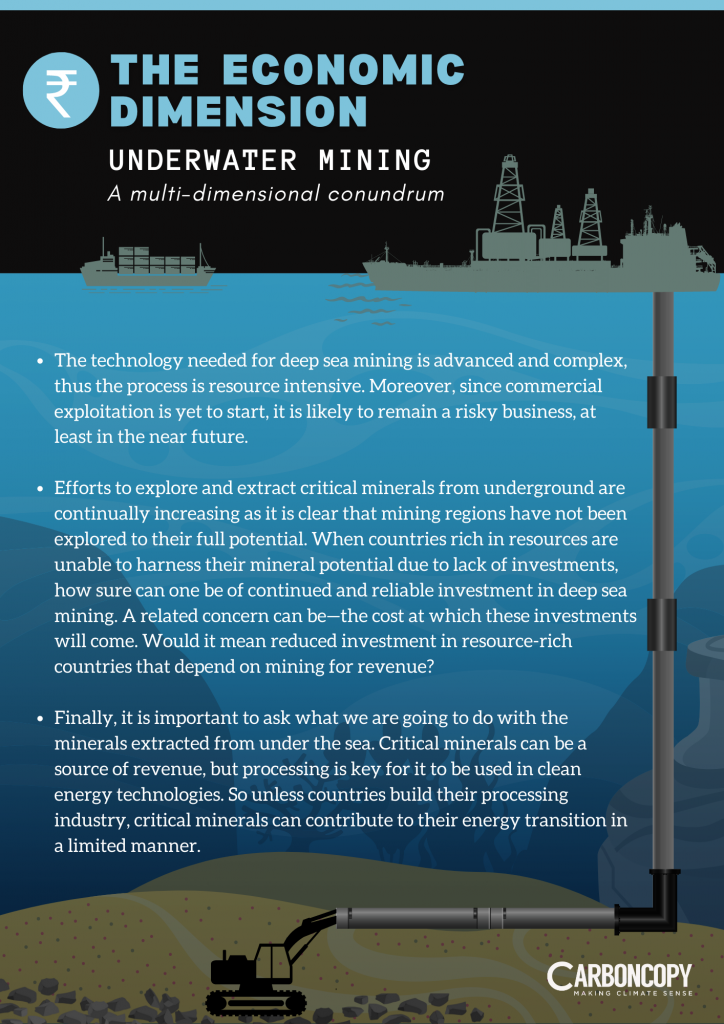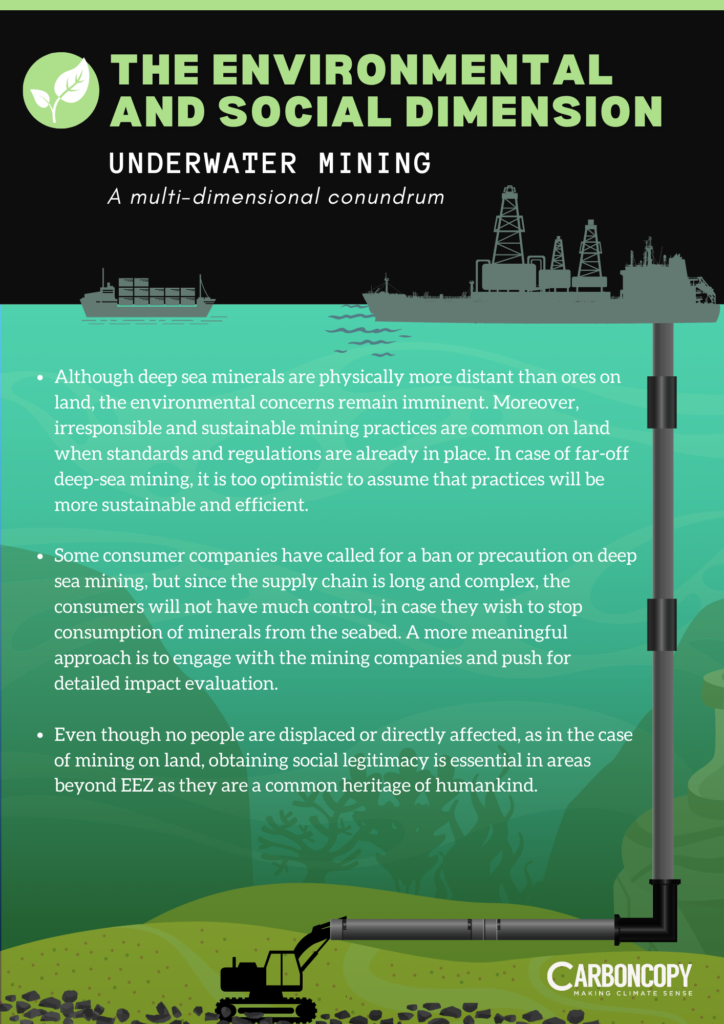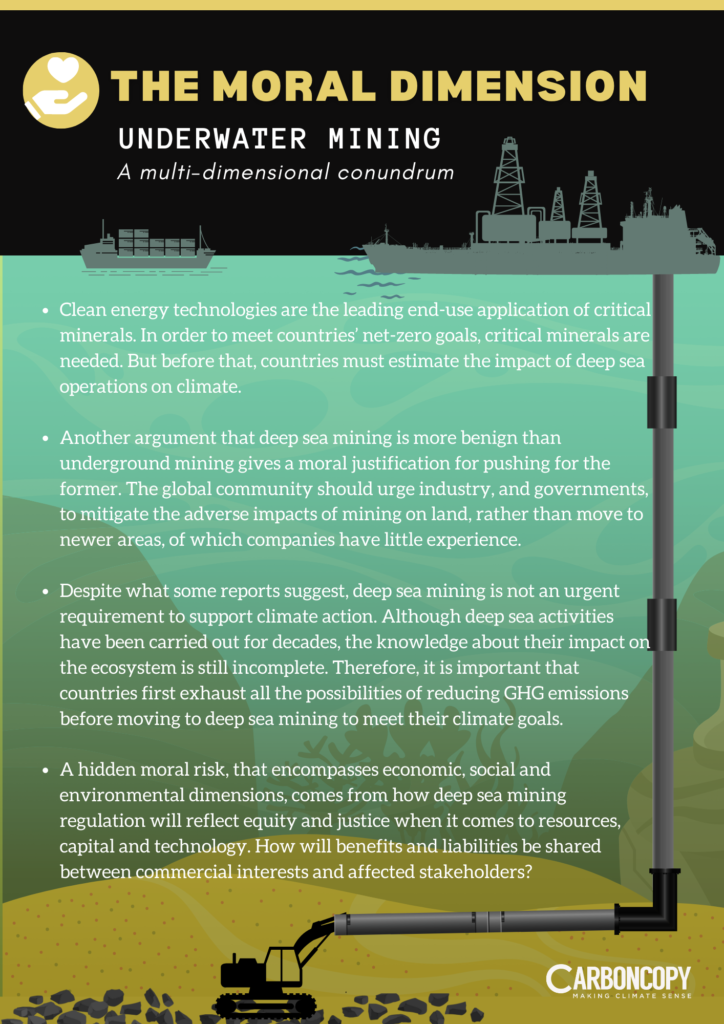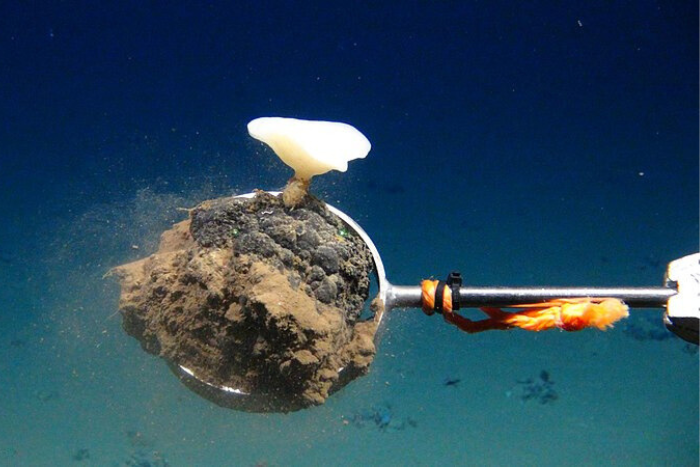While several countries are pulling away from deep sea mining largely due to concerns over biodiversity loss, India has taken significant steps in the recent past to facilitate it to meet its ambitious energy transition goal
The world is in the process of putting together a new energy economy—one that promises energy security without compromising on quality. Ever since such a low-emission economy was postulated, the massive resource requirement of such systemic change has been painted as inconvenient, but inevitable. The inevitability of this new “gold rush” for minerals and materials critical to the energy transition seems now to be coming to a head.
As a summer marked by extremes roiled the world, governments met in Kingston, Jamaica, in the last week of July to try and agree on regulation for the extraction of minerals from international waters. Although consensus remained elusive, the meeting did provide the clearest sign yet that the ambivalence is becoming increasingly untenable.
Meanwhile, closer home, India, like several other countries, is preparing to take a plunge into territorial waters in search of critical minerals. The recently concluded monsoon session of the Indian Parliament saw the passage of the Offshore Minerals (Development and Regulation) Amendment Act, 2023, which seeks to facilitate the exploration and extraction of critical minerals (also known as deep sea mining) in the territorial waters off India’s 7,500 km-odd coastline.
The deep sea mining brouhaha
The energy sector is the most significant contributor to GHG emissions, and any climate change mitigation action requires transition toward low-carbon pathways. This energy transition depends upon energy technologies that require a variety of critical minerals, such as lithium, cobalt, manganese, graphite, nickel, copper, chrome, and rare earths.
The International Energy Agency (IEA) estimates that climate targets would need at least four to six times more of these “critical” minerals by 2040. Such estimates have understandably attracted governments and industry to increase the exploration and extraction, and push for diversification of supplies. Besides land-based mining, sea beds are also being explored to harness the rich critical mineral reserves therein.
As the name suggests, deep sea mining is the process of extracting minerals from the deep sea bed or ocean floor. Deep sea nodules and deposits are rich in critical minerals such as nickel and cobalt. Mining these implies dredging of the sea bed and the deployment of heavy machinery to collect or pump the ore up to the surface.
Scientific community and civil society have raised concerns over the multitudinal risks and irreversible impacts of deep sea mining on marine ecosystem and biodiversity. But with the intersection of energy security, resource-independence and climate mitigation coming into sharp focus over the past few years, support for deep sea mining has grown stronger. One of the main supporting arguments is that mining critical minerals from the ocean floor will have a smaller environmental impact than mining them in tropical rainforests. Deep sea nodules are also claimed to have higher concentrations of minerals than terrestrial ores. Nevertheless, deep sea mining carries inherent risks to marine biodiversity, and neither the experience nor the standards exist to minimise impacts.

Whose sea is it anyway?
If a tree falls in a forest, and no one is around to hear it, does it make a sound? The answer of course is yes, but it does make the impact much easier to ignore.
In view of the large realm of unknown and incomplete understanding of the impacts and their management, policy discourse around deep sea mining is replete with demands from states, scientists, environmentalists and even industry to adopt a precautionary approach to allowing exploitation of minerals from the seabed. And herein lies the root of disagreement when it comes to international consensus on a common set of principles and rules for deep sea mining.
Under the International Law of the Seas, coastal states have the sovereign right to explore, exploit, conserve, and manage natural resources on and under the seabed in the exclusive economic zone, i.e., area up to 200 nautical miles from the baseline. Resources in the area of the seabed and ocean beyond this Exclusive Economic Zone (EEZ) are considered to be ‘the common heritage of mankind’, where no state can claim sovereignty or sovereign rights, and exploration and extraction of resources is to be ‘carried out for the benefit of mankind as a whole’.
The International Seabed Authority (ISA), an autonomous international organization established under the 1982 United Nations Convention on the Law of the Sea (UNCLOS) and the 1994 Agreement relating to the Implementation of UNCLOS, is responsible for the supervision and regulation of resource development from the seabed. Thus, deep sea mining within the EEZ is governed by domestic regimes, and mining beyond EEZ falls under the purview of the ISA.
As of now, the ISA has adopted regulations only for exploration activities in the seabed and ocean floor beyond national jurisdiction. The ISA reviews the applications and plans for exploration based on the Exploration Regulations for polymetallic nodules, polymetallic sulphides, and cobalt rich ferromanganese crusts. The applicants for contracts are mandated to provide evidence of technical and financial capabilities to carry out exploration, description and a schedule of the activities, a preliminary assessment of possible environmental impact and proposed measures to prevent, mitigate and control marine pollution. Guided by precautionary principles and the guidance document prepared by the Legal and Technical Commission of the ISA, contractors have to carry out an EIA prior to commencing any exploration activity.
Government entities, as well as private entities, can obtain ISA approvals for deep sea mining contracts in the area. Still, private entities must be sponsored by a state party to which they belong or through whom they are controlled. Thus, even with private companies taking a lead, state sponsorship ensures that there is some legal system with which these companies comply. Out of the 169 members of ISA, around 20 have sponsored government or private entities to enter into exploration contracts with ISA since 2002.
ISA Regulations for prospecting and exploration of deep sea mineral deposits have been in place for nearly two decades. However, the regulations for extraction have been in the making since 2014 and are still not finalised.
This is where the Pacific island-nation of Nauru enters the picture. Among the most vulnerable to sea-level rise and impacts of climate change, the country applied for permission to begin mineral extraction in the Clarion-Clipperton Zone in the North Pacific in June 2021. The application, made on behalf of Nauru Ocean Resources Inc (NORI), a subsidiary of a Canadian company DeepGreen, triggered a so-called “nuclear option” at the ISA, which gave the group a two-year deadline to finalise rules and facilitate the approval of Nauru’s proposal.
This window lapsed on July 9 this year, and with rules yet to be finalised, the “nuclear option” has thus far delivered more of a whimper than a bang. In its latest meeting, the ISA has given itself a two-year extension.
The past couple of years, though, have seen some progress. As reported by the Earth Negotiations Bulletin of IISD, at the 28th Session of ISA in March 2023, states agreed that firstly, there is no obligation to approve the plan of work, and secondly, a provisional approval of a plan of work does not amount to final approval or an exploitation contract.
However, operational issues such as guidelines, directives, or instructions, and the process to be followed after provisional approval are yet to be agreed upon. At the second negotiation of the 28th Session of the International Seabed Authority concluded on July 28, countries failed to reach consensus on rules, regulations and procedure (RRP) for extraction, and the Council has pushed the deadline to the ISA Session in 2025.
The consensus seems difficult to reach as some countries that had earlier been active in deep sea mining exploration have slowed down or paused, while there are others who are looking at increasing their exploration and moving towards exploitation of deep sea minerals. The interest shown by several companies, countries, and even the ISA has been put forth in the context of clean energy technology requirements, thereby providing an environmental justification for expediting the extraction of minerals from the seabed. Norway, China, and India have shown more interest in deep sea mining in recent times. Some of the countries that have halted their operations or called for a precautionary pause include Ireland, Germany, Spain, Chile, Ecuador, Vanuatu. Others like Switzerland, Fiji, Samoa and New Zealand call for a moratorium.

Coming to Indian shores now
India has set an ambitious energy transition goal of 500 GW of installed capacity of non-fossil based electricity by 2030 and reducing emissions intensity by 40%. The clean energy technologies that can help in attaining these goals require critical minerals, many of which are not produced in India. To this effect, the government has been trying to increase and encourage exploration, on land and offshore.
India has a 7,517km coastline and an exclusive economic zone of more than two million square-km. The vast coastal and marine territory is a reservoir of not only biodiversity, but also economic resources like crude oil, natural gas and other mineral resources. India’s territorial waters (an area up to 12 nautical miles from the coastal baseline) have been estimated to contain 79 million tonnes of heavy mineral resources based on the Geological Survey of India’s ‘limited capacity’ assessment.
In 2021, the National Institute of Ocean Technology, with its indigenously designed the deep sea mining machine, Varaha-1, undertook an exploration test collecting polymetallic nodules containing critical minerals like nickel, copper and cobalt from the Central Indian Ocean. This was quickly followed by the Deep Ocean Mission in 2021, launched by the Ministry of Earth Sciences. With the development of technologies for mining in Central Indian Ocean included as a key objective of the mission, the Samudrayaan Project for deep ocean exploration was announced in late-2021. Under this project, an exploration trial for Polymetallic Manganese Nodule was conducted at a depth of 5270m in December 2022. Last year, the Ministry of Earth Sciences also introduced the draft Blue Economy Policy, which had minerals as one of the focus areas. India’s interest in ocean-based economies was also reflected in its G20 agenda with considerable space devoted in the Climate, Environment and Sustainability Working Group outcome document, including the subject of exploration and exploitation of deep sea minerals.
Earlier this year, the Ministry of Mines invited comments on draft amendments to the Offshore Area Mineral (Development and Regulation) Act, 2002, to facilitate auction of deep-sea mining blocks for exploration licence-cum-production lease. The Offshore Areas Mineral (Development and Regulation) Amendment Act, 2023 was introduced and passed in Parliament during the recently concluded monsoon session. The amendment, made on the lines of the Mines and Minerals (Development and Regulation) Act for terrestrial minerals (which itself has been amended this year to expand private exploration and extraction), aims to encourage private participation in offshore mining. In addition to atomic minerals, some critical mineral deposits, such as those bearing beryllium, lithium, rare earths, niobium, titanium, zirconium, are reserved for government companies. Concerns have been raised against these measures by communities and civil society, but the government has maintained that these activities would not lead to overexploitation or adverse impact on the livelihoods of communities, but in fact may create additional opportunities in future.
Operating rights will be granted to the private sector through auction by competitive bidding for two types of contracts—production leases and composite licences. Composite licences have been described as a two-stage operating right to facilitate both exploration and extraction. Funds for preliminary explorations will be made available through a fund held under the Public Account of India and maintained by a non-lapsable ‘Offshore Areas Mineral Trust’. The fund will be replenished by an additional levy on mineral production—not exceeding one-third of the royalty.
India’s legislative support for deep sea mining has not come in isolation. At the international arena, India has been a member of the ISA since 1995. The Government of India (GoI) is one of the 22 entities worldwide that entered into exploration contracts with the ISA. GoI entered into a 15-year contract with the ISA in 2002 for the exploration of polymetallic nodules (PMN) and polymetallic sulphides (PMS) from a 75,000 sqkm area in the Central Indian Ocean. This contract was later renewed twice, and the Varaha-1 tests were carried out under this allocation by ISA.
It may be interesting to note that while several countries are pulling away from deep sea mining, India has renewed its contract with ISA recently and is looking to invest more in it. On his recent visit to India earlier this year, the Secretary General of ISA called India a ‘pioneer investor’ with the potential to become a leader in deep sea mining. The Indian government has, however, also maintained its stance supporting a balanced approach for the sustainable use of deep sea resources at the 28th Session of ISA.

A risky rush
While the ISA now has two-more years to frame regulation for extraction of deep sea minerals, the recently lapsed deadline has undoubtedly dented trust in the process. The pressure on the ISA to resolve the deadlock is now palpable, so is the sense of impatience. Even with the extension, the ISA has a weighty task at hand.
Firstly, A more proactive approach by ISA is needed in regulating the exploration of critical minerals. The Nauru example should serve as a reminder not just to ISA, but to all the countries that preparedness is crucial. Adopting a precautionary approach is important for signalling, but is useful only if the waiting period is used to develop standards, regulations, guidelines and institutions for governance. Since several countries and companies continue to invest in DSM, it is best to be prepared for a commercial exploitation scenario.
Secondly, more risk assessment studies and analyses are needed to avoid the rhetoric of land vs. sea mining in terms of environmental impact.
Finally, a much wider group of stakeholders need to be included in the discussion. ISA must invite views of more companies with mining as well as undersea activities to make informed decisions. Similarly, perspectives from the civil society should reflect concerns of environmental groups as well as those working in the area of energy and mining to understand the energy transition – deep sea mining linkage clearly.
ISA’s decisions on deep sea mining will carry far-reaching implications. While the economic rationale is writ large on the surface, dredging the depths of the issue reveal a far more complex reality, which will have to be weighed carefully for risks, both known and unknown.
Nidhi is an independent law and policy consultant based in New Delhi. She is writing her doctoral thesis on governance of critical minerals for energy transition.
About The Author
You may also like
Litigation increases legalisation of protection against climate threats: Report
What COP30 reveals about the next phase of multilateralism
The G20 Has Outrun COP on Climate Finance
EU to waste billions on hydrogen pipelines in new PCI list, warns experts
India needs targeted public finance to scale green steel production

